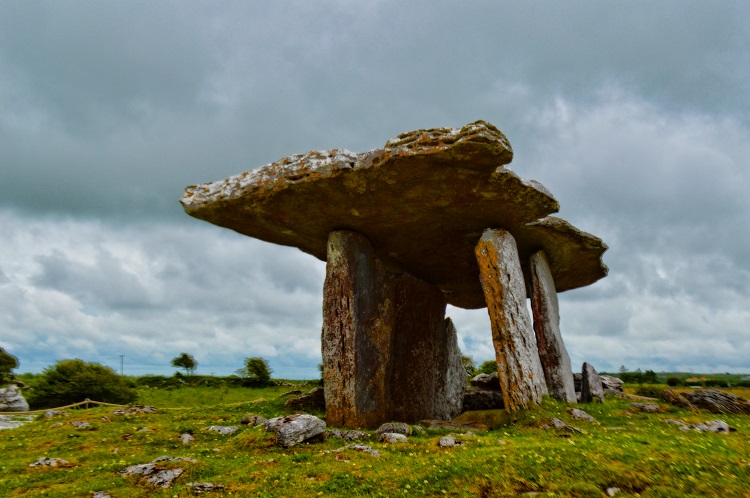Poulnabrone Dolmen Co Clare
During the ‘summer’ of 2015 my family and I went
off to south Galway to visit the assembled relations. While we were there we
organised a couple of day trips into the Burren, Co. Clare. On one of these we
visited The Burren Nature Sanctuary. It’s a
lovely place with plenty of activities for kids and a great restaurant too – if
you get the chance, go visit! There we were, basking in the glow of an excellent
lunch; sipping our coffees and discussing the favourite sights and sounds of
the day. As the Chapples Minor debated the varied merits of the animals they’d
encountered, I languidly played with my iDevice, attempting to decide where
we’d head for next. I was quite surprised when I saw that the beautiful
megalithic tomb of Poulnabrone was just 15 minutes’ drive away … my memory was
that Poulnabrone Dolmen was much further into County Clare, but maybe we
weren’t as close to Kinvara as I’d thought. I mooted the idea to the family
and, while no one was vastly over enthusiastic, they realised that I was in
need of an archaeology fix … after all, it wasn’t far away … what could
possibly go wrong? Well … for a start, your
GPS could lie to you … that 15 minute drive took about an hour, and all to
an occasional chorus of ‘are we there yet’ returned with ‘it can’t be too much
further … can it?’ Well, we eventually got there and it’s always worth the
effort to visit … even if you have to go further than expected to get there!
(Lesson: read a map & don’t trust the App on your phone so much!).
Poulnabrone is among the most recognisable and
iconic of all Irish megalithic tombs and, in particular, of the Portal Tomb class. The type
takes its name from way in which two jamb stones, along with a capstone form a
distinct door or ‘portal’. At Poulnabrone two relatively slender portal stones support
the large capstone, raising it to 1.8m off the ground. Together with the other
stones (two orthostats, an end stone, and a sill stone), they create a small
chamber. The whole is surrounded by a low cairn that’s about 9m in diameter. Unlike
the great passage tombs,
which were intended to be covered by their mounds, the cairn at Poulnabrone
appears to have always been around this current size and no larger and was intended
to assist in the stabilisation of the uprights. Today it appears as a lightly esporgent mound pushing the tomb further up into the skyline and out of the surrounding landscape.
In the mid-1980s a crack was noted in one of the
portal stones and the tomb partially collapsed soon after. The entire tomb was
dismantled and the broken stone was replaced. Excavations at the time uncovered
the disarticulated remains of 16 adults and six children, buried with a variety
of grave goods. These included a polished stone axe, a bone pendant, quartz
crystals, beads, a portion of a bone pin, a number of sherds of coarse pottery,
and a selection of flint and chert projectile points and scrapers. The main
period of use for the tomb was during the Neolithic period, from 3,800 BC to
3,600 BC, though it was reused during the Bronze Age. Around 1700BC the remains
of a newborn baby were interred in the portico, just beyond the entrance to the
tomb. Analysis of the human remains indicated that the occupants of the main
tomb had been defleshed elsewhere prior to being interred in the tomb. The
majority of the children died between the ages of five and 15, while the adults
rarely survived beyond 30 – thought one did get to roughly 40. The individuals
in the tomb appeared to have endured hard, physical conditions and many
exhibited evidence of arthritis, while others had healed fractures. Analysis of
the surviving teeth indicated that the people buried here ate coarse, stone-grounded cereals. Famously, one
individual was found to have had the tip of a projectile point embedded in his
hip … giving the lie to the myth of prehistory being some kind of cuddly, hippy
paradise of love and being at one with mother nature.
My photos were taken in failing light on a camera
with a fast fading battery. I’ve tried my best to resuscitate them with various
bits of computer trickery and filters, but the essential pedestrian nature of
my photography cannot be disguised. Instead, I urge you to get out and see this
wonderful monument for yourself … and take better pictures!
Resources:
Ancient Ireland









Comments
Post a Comment